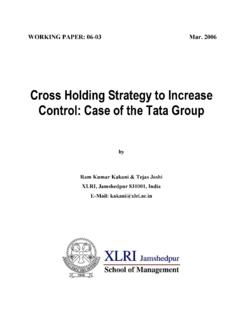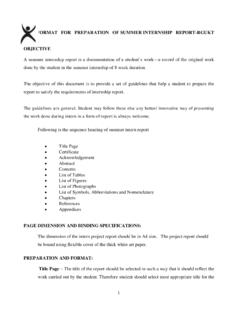Transcription of Nokia Case Study - hajarian.com
1 Nokia case Study Introduction: The fundamental question in the field of strategic management is how organisations achieve and sustain competitive advantage (Teece, et al, 1997) and therefore attain above industry-average profit. However, since both the business environment and individual firms are dynamic systems, continuously in flux, it is a big challenge to achieve a fit between these two systems (de Wit B and Meyer R., 2004) and therefore get the competitive advantage. This essay will firstly assess and consider the balance of market- led and resource-based approaches from the academic point of view. These two approaches should be viewed as complementary (Prahalad and Hamel, 1990; Mintzberg et al, 1995; Greenley and Oktemgil, 1996).
2 Following the discussion, the essay just analyzes Nokia 's strategies and empirically justified the reciprocal and complementary relationship between these two approaches. On the process of Nokia 's development, the company achieved success because it could balance these two approaches well. Once it failed to do so, the company immediately suffered the fall in 2004, lost market share and decreased the revenue. However, the company quickly recovered because it followed the market trends, and simultaneously its strong internal strengths neutralised the external threats. In addition, I will argue that Nokia can maintain its market share and its market leader position in the following years based on the good market opportunities in mobile phone industry and its strong internal resources basis.
3 Secondly, this essay will assess Nokia 's strategies in terms of emergent and planned approaches as well. Within the dynamic and complex mobile phone industry, both approaches are necessary if Nokia is to succeed. In conclusion, all four approaches discussed collectively promote Nokia 's success. Nokia case Study Part 1: Market-led and Resource based approaches Firms need to adapt themselves to market developments and they need to build on the strengths of their resource bases and activity systems' (de Wit B and Meyer R., 2004, p249). In reality, on one hand, some argue that an organisation needs to adapt itself to its environment. Managers should take the environment as the starting point, choose an advantageous market position and then gradually set up the resource base and activity system necessary to apply this choice.
4 On the other hand, some argue that the organisation can adapt the environment to itself. Managers are required to take the organisation's resource base as the starting point, selecting an environment to fit with its internal strengths (de Wit B and Meyer R., 2004). 1. According to the first view, successful companies are externally oriented and market- driven (Day, 1990; Webster, 1994), and this view is also referred to as outside-in' due to its focus on the environment (de Wit B and Meyer R., 2004). The companies with an outside-in perspective take the environment as the starting point, set on developments in the market-place and adapt themselves to the external opportunities and threats encountered. They use the signals from customers and competitors to decide their own game plan (Jaworski and Kohi, 1993).
5 So, for these successful companies, markets are leading, and resources are following' (de Wit B and Meyer R., 2004 ). Furthermore, proponents of this market-driven approach tend to emphasize that an insight into markets and industries is essential. They argue that not only the general structure of markets and industries need to be analyzed, but also specific demands, strengths, positions and intentions of all main forces need to be determined. As to Porter's view (1980, 1985), this approach has spawned five forces, generic strategy and value chain frameworks. What's more, many market-driven advocators suggest firms to initially lead market and industry to change, therefore, they can get the benefit from the altered rules of the game (de Wit B.)
6 And Meyer R., 2004). Smirchich & Stubbart (1985) agreed with this opinion, and already pointed out firms can, in part, create their environments through strategic alliances with stakeholders, investments in leading technologies, advertising and a variety of other activities. Concluding the advantages of this approach, Lieberman and Montgomery (1998) argued that firms that are market-driven are always the first ones to recognize that new resources or activities need to be developed. So those firms are better positioned can benefit from the first mover advantage'. More significantly, Market positioning is vital for the company's success. However, some argued that market positioning is vital, but must take place within the boundaries set by the resource-driven strategy (de Wit B and Meyer R.
7 , 2004). That is, the market position selected is adapted to fit the organization's resource base. So for successful companies, they need to firstly build up a strong internal resource base, and then based on this strong resource base they can access to unfolding market opportunities in the medium and short term. In essence, this inside-out' approach assumes that competitive advantage depends upon the behavior of the organisation, rather than its competitive environment (Stonehouse and Pemberton, 2002). Moreover, the proponents of this approach stressed that the importance of a firm's competences over its tangible resources (de Wit B and Meyer R., 2004). Strategists have variously referred to the basis of this strategy as competence based' (Prahalad and Hamel, 1990; Sanchez et al, 1996).
8 Or capabilities based' (Stalk et al, 1992; Teece et al, 1990). Collis and Montgomery (1995) also pointed out that having distinctive or core competences can be a very attractive basis for competitive advantage, since rival firms normally need to take a long time to catch up. Even if competitors are successful at identifying the competences and imitating them, the company with an initial leading position can still upgrade its 2. competences and stay ahead. So, for success, resources should be leading, and market following' (de Wit B and Meyer R., 2004, ). In practice, Hofer and Schendel (1978) found both positioning and resource deployment issues are critical for creating a competitive advantage. So, they argued that competitive superiority stems from the ability to align positional advantages and resource-based elements of strategy.
9 Meanwhile, some other experts further suggest that the two approaches should be viewed as complementary, since organisations need to develop both internal and external focus to develop knowledge-based core competences and market driven strategies sensitive to customer needs (Prahald and Hamel, 1990; Minzberg et al., 1995; Greenley and Oktemgil, 1996). Therefore, both approaches are needed to be considered and balanced simultaneously in making the strategic choice. Actually, Nokia can achieve the great success in the mobile phone industry, one important factor is that it can align these two approaches market-driven strategy and resource based strategy during the process of its development. Once it failed to do so, the company immediately suffered the fall, lost market share and decreased sales revenue.
10 Certainly, when the company aligned these two approaches again, the company got the recovery soon. In the following part, the essay will assess the company's strategy change between these two approaches and the results correspondingly. Since those early days, Nokia has evolved into a conglomerate encompassing several industries. With the collapse of the USSR in 1990, Nokia suffered the high pressure to survive in so many different areas. Based on the new market opportunity the company predicted in mobile phone industry and its internal strengths-advanced technology on mobile phone sector (the company had the world's first international cellular mobile telephone network and first producer of hand portable phones), Nokia finally decided to focus on mobile phone industry.





